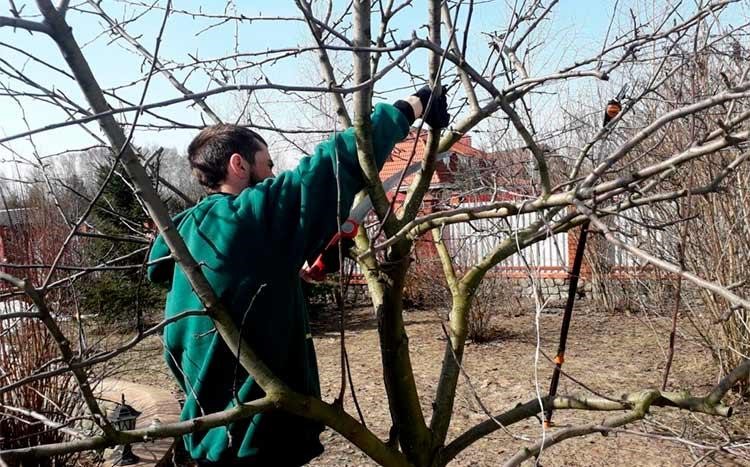Choosing the right time to trim/prune the tree or a shrub is essential for a good quality of life and the future of the plant. Trimming also contributes to establishing a good shape of the tree or shrub.
Winter and early spring are ideal times to trim/prune because the lack of leaves on trees and shrubs allows you to see what you are doing clearly.
The most important thing is that during the winter sap is not as active compared to the other times of the year and the tree or a shrub sustains less of a shock than being chopped when the sap is in full flow.
Why Winter or Early Spring?
Winter is the best time of year to trim a tree because This can be the time of the year when they’ve stopped dynamic development and have hunkered down for the cold climate.
Since of this torpidity, late winter, and early spring are regularly the most excellent times to form any alterations to the shapes of numerous trees and shrubs.
You need to prune difficult at the conclusion of winter or exceptionally early spring sometime recently any modern development begins. This permits the plant to put its vitality towards creating an unused, solid development when the hotter temperatures of spring roll around.
Essentially talking, it’s moreover a parcel less demanding to see the genuine shape of deciduous plants within the winter, since their foliage is gone.
Read Also:
Can All the Trees and Shrubs Be Pruned in The Winter and Early Spring?
Not all the trees and shrubs ought to be trimmed within the winter or early spring. For the most part, talking, shrubs, and trees that blossom on modern growth should be pruned within the winter and early spring, whereas those that blossom later ought to be trimmed in late spring or summer.
Tips for Trimming/Pruning in Winter and Early Spring
There are a few tips for trimming trees and shrubs which will help you to get a better result:
- Trim on a mellow, dry day. First is more pleasant for you to work, second, it makes a difference to avoid the spreading of waterborne plant illnesses or harm from cold temperatures;
- Never trim early in the winter, as cuts can dry out on the off chance that the temperature drops well underneath solidifying;
- When trimming, to begin with, trim out dead and ailing branches, particularly those caused by the winter’s snow and ice;
- Undesirable lower branches on all evergreen shrubs and trees ought to be evacuated in late winter;
- Evacuate congested and smaller branches to extend light and airflow at the crown of the tree;
- Cut branches at the hub, the point at which one department or twig connects to another.
Trees and Shrubs to Trim in Late Winter/Early Spring
| Type of tree/shrub | When to trim | How to trim |
| Apple | Late winter to early spring | Trim moderately. Keep tree open with main branches well-spaced. Avoid sharp V-shaped crotches. |
| Abelia | Late winter to early spring | Maintain a graceful arching form by cutting away some of the oldest stems at ground level. Pinch growing shoots in spring if you want bushier growth. |
| Azalea | Late winter or during the growing season | Before growth begins for the season, improve the form of the shrubby shortening stems that jut out of place. During the growing season, pinch growing shoots tips where you want bushier growth. |
| Butterfly shrub | Late winter | Cut all stems to the ground. |
| Chaste tree | Late winter to early spring | Evergreen species need little trimming beyond cutting out weak, twiggy, dead, or broken branches. |
| Cherry | Late winter to early spring | Trim the most vigorous shoots moderately. |
| Clethra | Early spring | Trim moderately. Keep tree open with main branches well-spaced. Avoid sharp V-shaped crotches. |
| Crape myrtle | Late winter | Wherever the plant is not totally winter-hardy, cut off winter-killed wood or cut the whole plant to the ground. A little trimming is needed where this plant is cold-hardy. |
| Dogwood | Late winter to early spring | Trim the most vigorous shoots moderately |
| Hibiscus | Early spring | Trim moderately. Keep tree open with main branches well-spaced. Avoid sharp V-shaped crotches. |
| Hydrangea | Mostly late winter | For smooth hydrangea, cut all stems to the ground. For bigleaf or oakleaf hydrangea, cut stems with old flowers still attached back to the fat flower bud. |
| Peach | Late winter to early spring | Remove half of last year’s growth. Keep the three-headed low. |
| Plum | Late winter to early spring | Cut dead, diseased branches, trim rank growth moderately. |
| Roses | Early spring | Cut dead and weak growth, cut branches or canes to four or five buds. |
| Smoke shrub | Late winter or early spring before growth begins | Needs little trimming unless you grow it for its purple leaves rather than for its flowers. In this case, trim severely to stimulate vigorous new growth each spring. |
FAQ’s
Can Trees Be Trimmed in The Winter?
Yes! Actually, trees can be trimmed at any time of the year, but winter is somehow the optimal time because of the dormant state of the tree. Trees are working hard to produce during the summer and spring.
When You Should Not Trim a Tree?
Some dead and damaged branches can and should be removed at any time of the year. But when it comes to the removal of healthy limbs, winter is a perfect time when the tree is essentially asleep, or in the early spring when the tree has just begun growing again.
What About Palm Trees?
Cutting down or removing palm trees is also a good idea in winter as there are no messy seeds or flowers on the tree. It will also be cheaper as the tree services industry is seasonal and slows down in winter.
Can You Prune in Freezing Weather?
Some species, like plums, for example, don’t have to be pruned in freezing weather because it can lead to the spread of silver-leaf disease.
Can You Prune Trees in January?
January is the top of the dormant season and a great time to prune shrubs and trees that could cause problems during winter storms.













